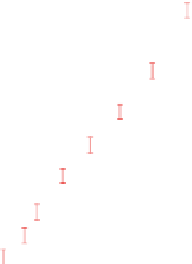Biology Reference
In-Depth Information
association constants measured at various temperatures are plotted
against inverse temperature in Fig. 5.2b, from which standard Gibbs
free energy is deduced,
0
∆
G
=
−
2
−
3 kcal/mol for the self-organized
PDI oligomer.
(b)
(a)
6.5
6.0
Ha
8.2
5.5
8.0
5.0
Hb
4.5
7.8
4.0
∆
G
o
= -2-3 Kcal/mole
3.5
7.6
4.0x10
-3
260
Temperature
280
300
3.4
3.6
3.8
1/T
Figure 5.2
Upfield shift of the aromatic protons at low temperatures
(a) indicates larger self-association constant
K
at low
temperatures (b).
In Fig. 5.2, chemical shifts of the sample and references were
measured as a function of temperatures and the self-association
constant
K
(
T
) is obtained by fitting those data at the corresponding
SA
temperature
to Eq. 5.2. The plot in Fig. 5.2b allows us to deduce
enthalpy and entropy changes according to the van't Hoff equation
(Eq. 5.3). For self-association of PDI derivatives, we obtained
T
0
∆
S
=
0
-17.5
0.19 kcal/mol. These results
indicate that self-organization of perylene derivatives is driven by
the exothermic enthalpy change while the system must overcome
the unfavorable entropy contribution to achieve an ordered state.
Whether or not the system undergoes self-organization will
depend on which contribution dominates the situation. In dilute
concentrations (<1 mM), perylene derivatives exist predominately
as free monomers and no self-organization occurs as evidenced by
the plateau region of NMR chemical shift in Fig. 5.1a. When the initial
concentration is high (>1 mM), intermolecular interactions increase
and self-organization becomes favorable owing to the exothermic
processes.
±
0.7 cal/mol•K and
∆
H
= -7.41
±







































Search WWH ::

Custom Search